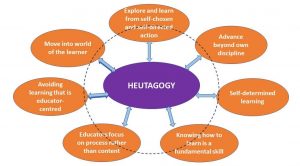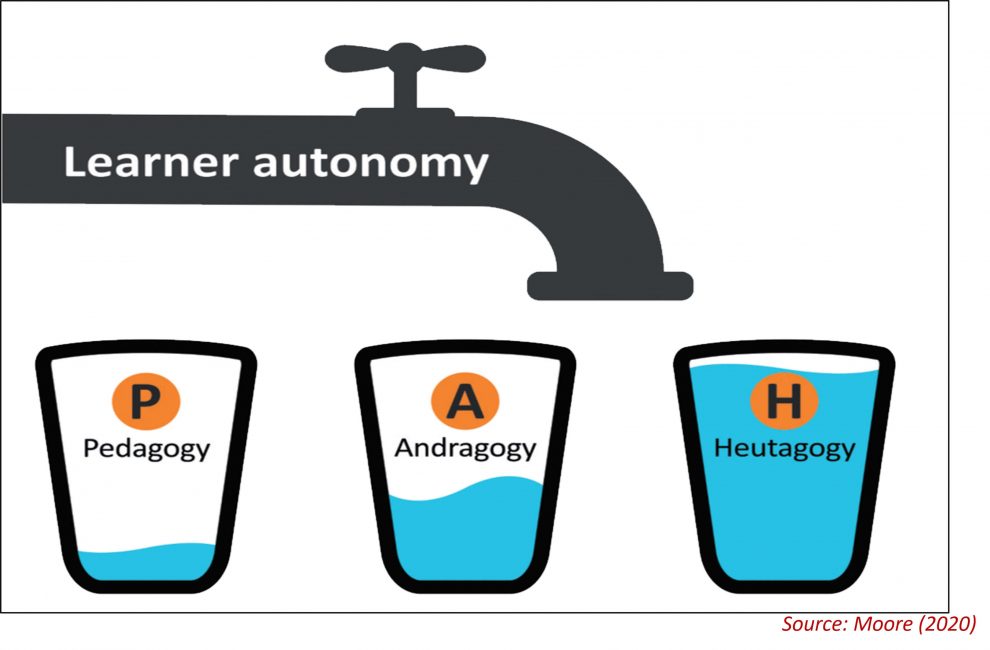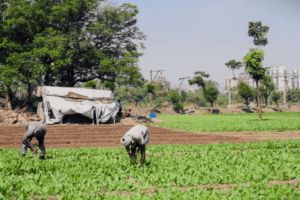Heutagogy is the methodology of learning for self-managed learners. It has relevance and application in professions that require lifelong learning. In this blog, R. M. Prasad discusses the principles and methodology of heutagogy and its potential application in education and extension in state agricultural universities.
CONTEXT
With information bombarding us through multiple sources, learning in educational institutions needs to be more relevant and authentic for the learner. This warrants a shift in the methodology of teaching. Self-directed learning (andragogy) and self-determined learning (heutagogy) are two pathways that can help students become ‘future ready’. The key difference between self-directed learning and self-determined learning is the double-loop capability of self-determined learning. Beyond problem solving, double-loop learning involves scrutinizing and questioning original concepts and learning processes. Reflection is a key aspect of increasing learning capabilities through double-loop learning. Self-determined learning revolves around ‘learning how to learn’. The best way to help students become ‘future ready’ is to guide them towards learning in a self-determined way. Applying heutagogy in the agricultural education system is the way to do so.
WHAT IS HEUTAGOGY?
Heutagogy is the management of learning for self-managed learners. In training, the desired objective of this learner-focused ecosystem is to enhance the capacity of trainees to identify core issues that are uniquely interesting and relevant to their learning curve. Trainee sets their own context-specific learning objectives. This main tenet of a heutagogical approach enables trainees to discover their own problems and questions to which they seek answers, which are satisfying and rewarding.
Heutagogy can be applied in education and extension systems in State Agricultural Universities (SAUs). It encourages students to find problems and questions to answer themselves. Instead of simply completing teacher-assigned tasks, students have the voice and choice in seeking out areas of uncertainty and complexity in the subjects they study. The teachers help by supplying context to students’ learning. In the heutagogical classroom, much of the learning is student-driven rather than traditional instructor-led. Students take a more active role in determining what is to be learned based on their own needs and interests and the instructor acts as a facilitator.
Before the concept of heutagogy was derived, Chris Kenyon and Stewart Hase designed a course that placed the learner at the center of the learning process, as full partners in designing their own learning (Hase and Kenyon, 2000). This is at the heart of heutagogy. The concept of heutagogy was derived as an extension to andragogy, and antithetical to pedagogy.
Differentiating Pedagogy, Andragogy and Heutagogy
In the triad of pedagogy-andragogy-heutagogy, there are basic differences in the approach, which need to be understood.
Pedagogy is the teaching of children or dependent individuals. Andragogy is the facilitation of learning for adults who are self-directed learners. Heutagogy is the management of learning for self-managed learners. Pedagogic theory is a systematic conceptualization of the process of education and conditions of human development in both the individual and the societal sphere. It deals with processes of upbringing, teaching, learning, and social and cultural development. Knowles’ theory of andragogy is an attempt to develop a theory specifically for adult learning. Knowles emphasizes that adults are self-directed and expect to take responsibility for decisions. Heutagogy is defined as a form of self-determined learning, which focuses on developing an individual’s capability and capacity to learn (Blaschke, 2012).
| Features | Pedagogy (child learning) |
Andragogy (adult learning) |
Heutagogy (self-directed learning) |
| Dependence | The teacher decides what, how and when a student should learn (dependent) | Adults strive for autonomy and self-direction in learning (independent) | Learners identify the potential to learn from experiences and manage their own learning, it is self- determined (interdependent) |
| Resources for learning | The teacher devises various techniques on the students to learn | Adults use their own and others’ experiences | The learner decides the learning path by negotiating the learning process |
| Reasons for learning | Learning to advance towards the next stage | Adults learn when they experience a need to perform more effectively | Learning is based on the identification of the potential to learn in novel situations |
| Focus of learning | Learning is focused on the prescribed curriculum and planned sequences | Adult learning is task or problem centered | Learning goes beyond problem solving by enabling proactivity |
| Motivation | From external sources (parents and teachers) | From internal sources (self-esteem and confidence) | Self-efficacy, knowing how to learn and working with others |
| Role of teacher/trainer | Designs the learning process | Enabler/facilitator | Develop the learner’s capability, capable people know how to learn |
Source: COLRS, University of Illinois.
Principles of Heutagogy
There are five main principles underpinning heutagogy (Blaschke and Hase, 2015):
- Learner agency: The central principle of heutagogy is learner agency, where the student is the primary agent of his/her learning, with the learner making decisions about learning, from what will be learned and how, to whether learning has been achieved and to what degree (e.g., self-assessment).
- Self-efficacy and capability: The principles of (1) self-efficacy, which is the learner’s belief in his/her own abilities, and (2) capability, which is the ability of the learner to demonstrate an acquired competency or skill in new and unique environments, have the potential to create transformational learning.
- Metacognition and reflection: Reflecting upon and critically thinking about what has been learned and the process of learning, in the form of double-loop learning (metacognition), is another principle of heutagogy.
- Non-linear learning: The learning path is directed by the learner, and is not pre-defined or sequential, as the learner is responsible for identifying what will be learned and how. As a result, this path can often be chaotic and divergent, but more effective.
- Learning how to learn: While this is partly inherent in the other principles, McAuliffe et al. (2008) single out this factor as a key principle of heutagogy.
 Fig 1. The principles of heutagogy Source. McAuliffe et al. (2008)
Fig 1. The principles of heutagogy Source. McAuliffe et al. (2008)
Heutagogic methodologies
The methodologies that can be used to design a heutagogic learning experience are not hierarchical or prescriptive. They are based on:
Negotiated learning: The learner is at the centre of heutagogy. Learners need to be able to negotiate the learning process and content, depending on what they want to explore and how they want to reach learning outcomes. One way of facilitating this process is to have the learner review his/her unique context.
Context: Enabling the learners to explore how they will apply the learning to their own context is critical to heutagogy. Learners do not enter into or leave a learning experience as a blank slate. Rather, they bring with them previous experiences, and they will take the learning from those experiences and apply it to new experiences.
Learning resources: Ensuring that the learner can access appropriate learning resources is key to any heutagogic learning experience. The provided resources are not intended to be exhaustive; rather they should be adequate and indicative, so that learners can explore further as part of learning to be effective practitioners.
Collaborative learning: Learners learn from each other, so the trainer needs to be able to establish a means of communication among learners, either face-to-face or using mobile technology, or both.
Questioning: An important skill for the heutagogue is the skilled design and asking of questions. The questions should not concern content; instead, questions should encourage exploration, reflection, insight and creativity.
Negotiated assessment: The design of assessment that provides the learner with the freedom to assign context, explore beyond the outcomes, to be creative, to innovate and to demonstrate capability, is an important skill and a departure from providing standardized assessments.
While heutagogy was theorised in 2000, it remained largely unacknowledged and underutilized until the rise of social media tools (Blaschke,2012). Narayan et al (2019) conducted a study that investigated how mobile and social media tools and affordances could be harnessed to facilitate a student determined learning experience. A design based research (DBR) approach was utilised to analyse and investigate a set of draft design principles that was established in collaboration with a group of teachers and literature.
APPLICATION OF HEUTAGOGY IN AGRICULTURAL UNIVERSITIES
Heutagogy can be applied in the education and extension system in agriculture.
Education
The principles of heutagogy can be applied among students and teachers in the system and the changes it can bring to the education system in agriculture can be studied and refined. Heutagogy also finds application in the curriculum design of courses in the field of agriculture. The Deans Committee constituted by ICAR and responsible for finalizing the agricultural curriculum at the undergraduate level may take the lead in this. In European/American universities, a certain percentage of every course syllabus is left for students to learn on their own (one of the applications of heutagogy). When students learn on their own, they learn to explore the content relevant to the topics, an learn to think, discuss and understand its implications in the real world. Similarly, the Rural Agricultural Work Experience (RAWE) programme can be effectively transformed and refined using heutagogical principles.
The New Education Policy (NEP) 2020 has indicated that ‘the design of agricultural education will have to be strengthened towards developing professionals’ with the ability to understand and use local knowledge, traditional knowledge and emerging technologies. As per its recommendations, the Indian Council of Agricultural Research (ICAR) shall act as a Professional Standard Setting Body (PSSB) for agricultural education to develop curricula and lay down academic standards for agricultural education. Given the available alternative modes of quality education, there is a need to complement/enrich traditional and in-person modes of education (Agrawal, 2022)
A study by Kalule et al. (2023) revealed that fulfilling farmers’ learning needs influences intrinsic motivation, formation of learning intentions and farmer learning behavior. Gillaspy and Vasilica (2021) suggest that a heutagogical approach has the potential to develop learners who demonstrate key principles of heutagogy, including non-linear learning, learner agency, capability, self-reflection and metacognition and double-loop learning. Their study provides insight into the process of developing a self-determined learner and encourages further research into flexible and learner-centric approaches across disciplines in higher education.
Extension
Heutagogy must be an inherent trait in extension professionals. How they must be prepared and flexible in the teaching process to meet the purpose of the extension service and the needs of their clientele is an important concern. The concept is more applicable to social scientists/social science professionals where there are many instances where one needs to learn on one’s own to meet the purpose.
Though Krishi Vigyan Kendra (KVK) trainings follow the experiential learning (EL) approach, in practice the trainings are designed by trainers and follow a learning sequence that is characteristic of a pedagogical approach, without the involvement of trainees. The process tends to be that of guided learning and not self-directed learning, hampers the effectiveness of trainings and in no way helps to develop the competence and capability of farmer trainees.
In heutagogic training, trainees are given the opportunity to think deeply about a problem and the actions they have taken to solve it and critically reflect upon the problem-solving process itself. The trainers only act as facilitators who help the trainees become self-directed in the learning process. Heutagogy demands a transformed trainer role. With information now being widely available at the click of a mouse, the trainer is no longer the sole subject expert. The trainee should be at the centerstage of the learning process and the trainer should only be a facilitator. In the heutagogical approach, the learning process shifts focus from receiving learning inputs to analyzing those inputs. This is a critical skill for learners as they interact with a society in which knowledge management is more valuable than its access. The desired outcome of this self-directed learning approach is to enhance the abilities of trainees to identify salient issues that are personally more interesting and most relevant and then orchestrate learning activities that result in meaningful cognitive growth and behavior change. However, the knowledge of technology tools is critical for any trainer in order to be successful in the heutagogical approach.
For instance, let us consider organic farming as the content of KVK training. It is known that farmers receive a lot of information about organic farming from various sources. During the trainings, they get an opportunity to critically analyze the information they have acquired with the help of trainers who act as facilitators and aid them to develop a learning path to their satisfaction and competence. Different technologies can be used by trainers to make farmers critically reflect on the issues and problems associated with their adoption of organic practices in the field. This gives farmers the opportunity to share their experiences (both positive and negative), clarify their doubts and apprehensions and come out with a clear action plan. In this way, learning becomes more interesting as well as applicable.
END NOTE
The Deans Committee ensures the quality of agricultural education, revision of course curricula and suggests new approaches to make teaching more effective. The Committee can suggest the application of the principles of heutagogy among students and teachers in the SAU system and study the possible changes that it can bring to the agricultural education system. How the RAWE programme can be suitably transformed and refined using heutagogical principles can also be explored. In short, the best way to help students become ’future ready’ is to guide them towards learning in a self-directed way via heutagogy.
References
Agrawal, R.C. (2022). New paradigms in agricultural education in India. Indian Journal of Plant Genetic Resources. 35 (3), 50-52
Blaschke, L.M. (2012). Heutagogy and lifelong learning: A review of heutagogical practice and self-determined learning. The International Review of Research in Open and Distributed Learning. 13(1), 56-71.
Blaschke, L.M. and Hase, S. (2015). Heutagogy: A holistic framework for creating 21st century self-determined learners. In M.M. Kinshuk and B. Gros (Eds.). The future of ubiquitous learning: Learning designs for emerging pedagogies (25-40). Springer, Berlin, Heidelberg.
COLRS, University of Illinois, Pedagogy, Andragogy and Heutagogy.
https://www.uis.edu/colrs/teaching-resources/foundations-good-teaching/pedagogy-andragogy-heutagogy
Gillaspy, E. and Vasilica, C. (2021). Developing the digital self-determined learner through heutagogical design. Higher Education Pedagogies. 6 (1), 135-155. https://doi.org/10.1080/2375 2696.2021 . 1916981
Hase, S. and Kenyon, C. (2000). From andragogy to heutagogy. Ulti-BASE In-Site. https://edtechbooks.org/-vLnr.
Kalule, S., Sseguya, H., Karubanga, G. and Ongeng, D. (2023). Motivational pathways for farmer learning behaviour in the student‐to‐farmer university outreach. International Journal of Training and Development. https://doi.org/10.1111/ijtd.12298
McAuliffe, M., Hargreaves, D., Winter, A. and Chadwick, G. (2008). Does Pedagogy still rule? In Mann, L, Howard, P, & Thompson, A (Eds.) Proceedings of the 19th Annual Conference for the Australasian Association for Engineering Education: To Industry and Beyond. Faculty of Sciences, Engineering and Health, CQUniversity, Australia, 1-6. https://www.researchgate.net>figure>Principles-of-heutagogy
Moore, R. L. (2020). Developing lifelong learning with heutagogy: contexts, critiques, and challenges. Distance Education. 41(3), 381-401. https://doi.org/10.1080/01587919.2020.1766949
Narayan, V., Herrington, J. and Cochrane, T. (2019). Design principles for heutagogical learning: Implementing student-determined learning with mobile and social media tools. Australasian Journal of Educational Technology. 35 (3): 86-101
 Dr. R. M. Prasad is a retired Professor of Agricultural Extension from Kerala Agricultural University. He worked in two EU-funded projects in Kerala viz., Kerala Horticulture Development Project (KHDP) Kerala Minor Irrigation Project (KMIP). He also has work experience at NIRD & PR, Hyderabad and Government of Meghalaya, Shillong. He can be contacted on 9447832118 and e-mail: drrmprasad@gmail.com.
Dr. R. M. Prasad is a retired Professor of Agricultural Extension from Kerala Agricultural University. He worked in two EU-funded projects in Kerala viz., Kerala Horticulture Development Project (KHDP) Kerala Minor Irrigation Project (KMIP). He also has work experience at NIRD & PR, Hyderabad and Government of Meghalaya, Shillong. He can be contacted on 9447832118 and e-mail: drrmprasad@gmail.com.





Add Comment